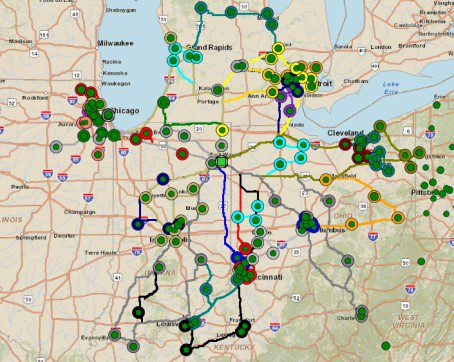Combating the Driver Shortage Problem with Transportation Optimization
 North America is facing a huge shortage of truck drivers, and the problem is expected to get worse. In order to continue moving product, trucking companies are pushing more and more freight onto the rail system, but that solution is not sustainable as it is also showing signs of being at capacity. Service in both modes is getting worse. The American Trucking Association cites a shortage of approximately 35,000 drivers, which is projected to rise as the struggle to find qualified drivers continues (Reuters, 2014). There are numerous reports of trucking companies refusing hundreds of truckload shipments every day. A former colleague mentioned that his trucking company refuses 825 truckload shipments per day due to the driver shortage. He also stated that one of the largest truckload carriers in the industry is refusing 1,800 loads per day. The amount of potential revenue lost by carriers—and the overages paid by shippers for not using their primary carriers–is staggering. Here are just a few of the reasons for this scarcity:
North America is facing a huge shortage of truck drivers, and the problem is expected to get worse. In order to continue moving product, trucking companies are pushing more and more freight onto the rail system, but that solution is not sustainable as it is also showing signs of being at capacity. Service in both modes is getting worse. The American Trucking Association cites a shortage of approximately 35,000 drivers, which is projected to rise as the struggle to find qualified drivers continues (Reuters, 2014). There are numerous reports of trucking companies refusing hundreds of truckload shipments every day. A former colleague mentioned that his trucking company refuses 825 truckload shipments per day due to the driver shortage. He also stated that one of the largest truckload carriers in the industry is refusing 1,800 loads per day. The amount of potential revenue lost by carriers—and the overages paid by shippers for not using their primary carriers–is staggering. Here are just a few of the reasons for this scarcity:- Truck driving can be unpleasant, with extensive time away from home and stress of traffic and varying demands of the shipper/receiver/carrier
- Pay is often relatively low. Drivers are often paid per mile driven, which doesn’t take into account non-driving “downtime” workers experience while on the job
- Government regulations, including driver hours-of-service limits, electronic monitoring of driver logs, etc. A cap on the number of days that drivers can work and a relocation of distribution centers closer to customer bases make deliveries more frequent, yet less profitable for drivers (USA Today, 18 May 2014).
- During the economic slowdown, many drivers were forced to leave the industry and then found other professions
- It is difficult to attract new labor to the profession
Trucking companies are providing paid training and signing bonuses, but still can’t reduce their turnover rates. Pay rates for drivers are being forced to go up and those costs will be passed to shippers in higher freight rates and then on to the products they ship. Put simply, shippers are trying to find carriers to haul their loads. Carriers do not have enough drivers to haul them, and are even using 3PL freight brokers to help find anyone to haul their loads. Service is suffering on all fronts.
Use Transportation Network Design to Mitigate Effects of Driver Shortage
Many shippers make the mistake of continuously using an inefficient approach, or adjusting parts of the transportation network in isolation. Instead, take a deeper look at your end-to-end distribution and transportation network. Maybe it needs a redesign to better respond to current conditions and costs, and a method of continuously re-evaluating the supply chain and transportation network to adopt the optimal structure and routes. Using supply chain modeling technology, businesses model their entire supply chain network, incorporating alternate transportation options and key variables such as cost, time, capacity and delivery parameters. Then choose an optimal transportation plan based on the total costs and service constraints. Here are some ways to do this:
Many shippers make the mistake of continuously using an inefficient approach, or adjusting parts of the transportation network in isolation. Instead, take a deeper look at your end-to-end distribution and transportation network. Maybe it needs a redesign to better respond to current conditions and costs, and a method of continuously re-evaluating the supply chain and transportation network to adopt the optimal structure and routes. Using supply chain modeling technology, businesses model their entire supply chain network, incorporating alternate transportation options and key variables such as cost, time, capacity and delivery parameters. Then choose an optimal transportation plan based on the total costs and service constraints. Here are some ways to do this:
Build a baseline model to visualize and assess the current situation
Before you can make the right changes, you first need to assess if there are opportunities in your current network for improvement. Building a baseline model of the as-is supply chain can open your eyes to inefficiencies and opportunities to consolidate shipments, increasing shipment sizes to maximize your use of truckloads. Organizations can also utilize modeling to analyze the possibility of decreasing costs through the use of hubs, cross-docks and pool points to build larger loads as well as the reassignment of sources.
Before you can make the right changes, you first need to assess if there are opportunities in your current network for improvement. Building a baseline model of the as-is supply chain can open your eyes to inefficiencies and opportunities to consolidate shipments, increasing shipment sizes to maximize your use of truckloads. Organizations can also utilize modeling to analyze the possibility of decreasing costs through the use of hubs, cross-docks and pool points to build larger loads as well as the reassignment of sources.
Consider alternate modes of transportation
Customers need products regardless of the vendors’ logistical issues. For that reason it is wise to consider different modes of transportation, be it air, ship or rail to alleviate the capacity concerns facing the trucking industry.
Customers need products regardless of the vendors’ logistical issues. For that reason it is wise to consider different modes of transportation, be it air, ship or rail to alleviate the capacity concerns facing the trucking industry.
Assess inventory right-sizing and/or the use of private fleets
Consider right-sizing inventory to meet desired service levels at the lowest possible cost. While alleviating capacity concerns, it can also save companies millions of dollars. Additionally, assess the cost implications of utilizing private fleets to determine if it may be a viable option for your organization. Fleet optimization enables businesses to create multi-stop routes with the right fleet mix. This balances optimizing fleet size while identifying efficient multi-stop vehicle routes, maximizing utilization. Approaches such as continuous moves shipment interleaving enables planners to schedule interleaved pick-ups and drop-offs within cohesive routes, while considering right-sizing the fleet and mode selection. This reduces the overall transportation system cost by right-sizing the fleet, determining optimal interleaved multi-stop routes, and considering direct shipment costs.
Consider right-sizing inventory to meet desired service levels at the lowest possible cost. While alleviating capacity concerns, it can also save companies millions of dollars. Additionally, assess the cost implications of utilizing private fleets to determine if it may be a viable option for your organization. Fleet optimization enables businesses to create multi-stop routes with the right fleet mix. This balances optimizing fleet size while identifying efficient multi-stop vehicle routes, maximizing utilization. Approaches such as continuous moves shipment interleaving enables planners to schedule interleaved pick-ups and drop-offs within cohesive routes, while considering right-sizing the fleet and mode selection. This reduces the overall transportation system cost by right-sizing the fleet, determining optimal interleaved multi-stop routes, and considering direct shipment costs.
Logistics providers can offer much more than just a vehicle to move goods from Point A to Point B. With the use of sophisticated supply chain design they can improve efficiencies and offer options to their customers by utilizing the scenario technology. Changes are likely on the horizon for the transportation industry but utilizing transportation and fleet optimization can help organizations continue to push their business forward despite these limitations.

No comments:
Post a Comment